Geology 307: Igneous and Metamorphic Petrology (Spring 2015)
Item set
- Title
- Geology 307: Igneous and Metamorphic Petrology (Spring 2015)
- Creator
- Tamara Carley
- Date Created
- 22 January 2015
Items
-
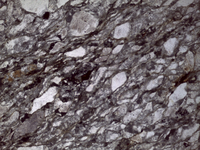 A green, chlorite and quartz Schist (or Greenschist)
A green, chlorite and quartz Schist (or Greenschist) -
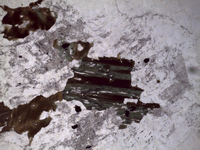 In hand sample, large grains of euhedral potassium feldspar. Anhedral plagioclase and quartz. Sizable hornblende and biotite crystals scattered throughout. In thin section, akali feldspar, plagioclase feldspar, quartz, hornblende, and biotite can be found. Perthite, the intergrowth between alkali feldspar and albite, is present. Many hornblende crystals are preserved that are being replaced with chlorite. The phaneritic texture in both hand sample and thin section suggests that this is a plutonic rock.
In hand sample, large grains of euhedral potassium feldspar. Anhedral plagioclase and quartz. Sizable hornblende and biotite crystals scattered throughout. In thin section, akali feldspar, plagioclase feldspar, quartz, hornblende, and biotite can be found. Perthite, the intergrowth between alkali feldspar and albite, is present. Many hornblende crystals are preserved that are being replaced with chlorite. The phaneritic texture in both hand sample and thin section suggests that this is a plutonic rock. -
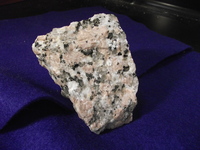 MACROSCOPIC: Large anhedral crystals of Potassium Feldspar, Quartz, and Plagioclase Feldspar with some smaller crystals of Biotite. MICROSCOPIC: Coarse grains of perthite consisting of Potassium Feldspar with Albite exsolutions along with coarse grains of Quartz and simple twinned Plagioclase Feldspar. Biotite is prominent throughout, along with smaller crystals of high birefringent Muscovite.
MACROSCOPIC: Large anhedral crystals of Potassium Feldspar, Quartz, and Plagioclase Feldspar with some smaller crystals of Biotite. MICROSCOPIC: Coarse grains of perthite consisting of Potassium Feldspar with Albite exsolutions along with coarse grains of Quartz and simple twinned Plagioclase Feldspar. Biotite is prominent throughout, along with smaller crystals of high birefringent Muscovite. -
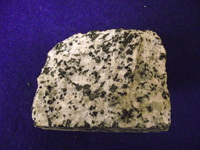 This phaneritic rock contains high amounts of sodic plagioclase feldspar, biotite, and hornblende. There is chlorite present in the thin section; as it usually forms from biotite. This rock could've formed in an area where slow cooling took place; perhaps at a medium depth to account for the presence of hornblende and biotite.
This phaneritic rock contains high amounts of sodic plagioclase feldspar, biotite, and hornblende. There is chlorite present in the thin section; as it usually forms from biotite. This rock could've formed in an area where slow cooling took place; perhaps at a medium depth to account for the presence of hornblende and biotite. -
 R1827 is a light grey prophyritic intermediate extrusive igneous sample.
R1827 is a light grey prophyritic intermediate extrusive igneous sample. -
 Diorite Location: Near Azusa, Los Angeles County, California Geologic Age: Cretaceous Megascopic Description: A dark gray medium grained somewhat gniessoid rock consisting of black hornblende, glassy plagioclase, with occasional yellow/brown grains or sphene. Microscopic Description: Green hornblende, the dominant species contributes to a moderately well-developed gniessoid foliation in the subparallel subhedra, partly replaced by Biotite, in both anhedral and patches and euhedral tablets. The medium plagioclase in anhedral, slightly zoned gradationally and locally has central parts sericitized. Large sphene euhedra form a conspicuous accessory. Others are Epidote, rare allanite, apatite, and magnetite
Diorite Location: Near Azusa, Los Angeles County, California Geologic Age: Cretaceous Megascopic Description: A dark gray medium grained somewhat gniessoid rock consisting of black hornblende, glassy plagioclase, with occasional yellow/brown grains or sphene. Microscopic Description: Green hornblende, the dominant species contributes to a moderately well-developed gniessoid foliation in the subparallel subhedra, partly replaced by Biotite, in both anhedral and patches and euhedral tablets. The medium plagioclase in anhedral, slightly zoned gradationally and locally has central parts sericitized. Large sphene euhedra form a conspicuous accessory. Others are Epidote, rare allanite, apatite, and magnetite -
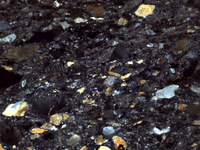 Near Grafton. Rensselaer County, New York Upper Devonian Mega: Gray rock with scattered angular grains of quartz and feldspar in a fine-grained matrix Micro: Poorly sorted rick with variably sized and angular quartz and feldspar pieces, set in a finer grained matrix of chlorite, sericite, carbonate, silky quartz, leucoxene, magnetute and pyrite
Near Grafton. Rensselaer County, New York Upper Devonian Mega: Gray rock with scattered angular grains of quartz and feldspar in a fine-grained matrix Micro: Poorly sorted rick with variably sized and angular quartz and feldspar pieces, set in a finer grained matrix of chlorite, sericite, carbonate, silky quartz, leucoxene, magnetute and pyrite -
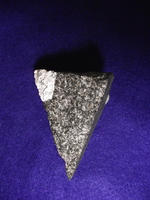 This mafic rock is very typical to oceanic-oceanic divergent margins and intra-plate volcanoes. Both the hand sample and thin section display phaneritic texture. The most recognizable minerals within this rock are 50% Feldspars, 30% Augite, and 20% Olivine. Due to Olivine making up more than 10% of the overall composition, the rock can be called an Olivine Gabbro. Based on the intergrain relationships within the thin section it is evident that Augite and Olivine formed first. The large embayments within the Augite and the surrounding Feldspar grains suggest resorption within the melt. The rock likely formed near an intra-plate volcano because as it rose through the mantle Augite and Olivine first crystallized, due to their mafic composition. As the location came closer to the surface the silica content increased and Feldspar grains demanded similar ions within the Augite crystals. This is what caused textures due to resorption of the crystals.
This mafic rock is very typical to oceanic-oceanic divergent margins and intra-plate volcanoes. Both the hand sample and thin section display phaneritic texture. The most recognizable minerals within this rock are 50% Feldspars, 30% Augite, and 20% Olivine. Due to Olivine making up more than 10% of the overall composition, the rock can be called an Olivine Gabbro. Based on the intergrain relationships within the thin section it is evident that Augite and Olivine formed first. The large embayments within the Augite and the surrounding Feldspar grains suggest resorption within the melt. The rock likely formed near an intra-plate volcano because as it rose through the mantle Augite and Olivine first crystallized, due to their mafic composition. As the location came closer to the surface the silica content increased and Feldspar grains demanded similar ions within the Augite crystals. This is what caused textures due to resorption of the crystals. -
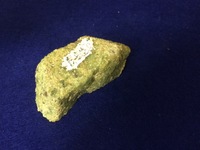 MEGASCOPIC: A light green granular rock composed almost etirely of glassy olivine with small black grains of chromite and a few large flakes of pale mica. MICROSCOPIC: A mosaically-textured aggregate of anhedral olivine. Chromite occurs in scattered subhedra. Accesories that appear in some sections are chlorite, phlogopite, brucite and a fibrous amphibole
MEGASCOPIC: A light green granular rock composed almost etirely of glassy olivine with small black grains of chromite and a few large flakes of pale mica. MICROSCOPIC: A mosaically-textured aggregate of anhedral olivine. Chromite occurs in scattered subhedra. Accesories that appear in some sections are chlorite, phlogopite, brucite and a fibrous amphibole -
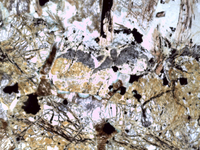 Porphyritic highly mafic igneous rock that may have undergone some degrees of contact metamorphism.
Porphyritic highly mafic igneous rock that may have undergone some degrees of contact metamorphism. -
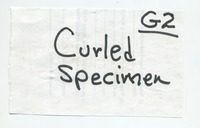
-
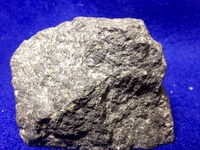 This sample exhibits a porphyritic texture in both hand sample and thin section. In hand sample, the dominant igneous features are olivine phenocrysts and vesicles. In thin section, the matrix that the olivine phenocrysts sit in is composed of microlites of plagioclase that exhibit lamellar twinning and compositional zoning. The vesicles show as clear gaps in plane light and black voids in cross-polarized light. This rock formed at depth where the Olivine phenocrysts had the time to accumulate but not enough time for plagioclase to form large crystals - the prophyritic texture is due to a quick cooling stage of the melt from eruption where the remaining melt stops crystallization.
This sample exhibits a porphyritic texture in both hand sample and thin section. In hand sample, the dominant igneous features are olivine phenocrysts and vesicles. In thin section, the matrix that the olivine phenocrysts sit in is composed of microlites of plagioclase that exhibit lamellar twinning and compositional zoning. The vesicles show as clear gaps in plane light and black voids in cross-polarized light. This rock formed at depth where the Olivine phenocrysts had the time to accumulate but not enough time for plagioclase to form large crystals - the prophyritic texture is due to a quick cooling stage of the melt from eruption where the remaining melt stops crystallization. -
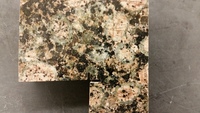 Rapakivi texture. Overgrowths of Plagioclase on grains of Alkali Feldspars.
Rapakivi texture. Overgrowths of Plagioclase on grains of Alkali Feldspars. -
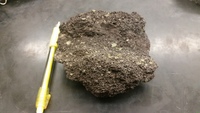 Scoriaceous Basalt Containing Olivine Crystals. Vesicular groundmass with olivine phenocrysts. No thin section present.
Scoriaceous Basalt Containing Olivine Crystals. Vesicular groundmass with olivine phenocrysts. No thin section present. -
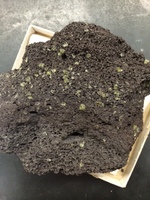 Highly vesicular porphyritic basalt containing large olivine crystals in a fine grained groundmass. There is currently no thin section of this sample, but the groundmass likely contains pyroxene, amphibole, and Ca-rich plagioclase.
Highly vesicular porphyritic basalt containing large olivine crystals in a fine grained groundmass. There is currently no thin section of this sample, but the groundmass likely contains pyroxene, amphibole, and Ca-rich plagioclase. -
 Porphyritic Basalt with elongate plagioclase phenocrysts; euhedral shape due to lack of crystal intergrowth.
Porphyritic Basalt with elongate plagioclase phenocrysts; euhedral shape due to lack of crystal intergrowth. -
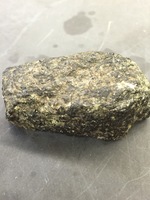 Megascopic: medium-grained dark gray rock, consisting of plagioclase and olivine with minor pyroxene. Microscopic: completely anhedral augite contains exsolved films of iron oxide species, may form reaction rims on altered olivine (corona structure). Olivine is largely altered.
Megascopic: medium-grained dark gray rock, consisting of plagioclase and olivine with minor pyroxene. Microscopic: completely anhedral augite contains exsolved films of iron oxide species, may form reaction rims on altered olivine (corona structure). Olivine is largely altered. -
 Megascopic: A light green granular rock composed almost entirely of glassy olivine with small black grains of chromite and a few large flakes of pale mica. Microscopic: A mosaically-textured aggregate of anhedral olivine. Chromite occurs in scattered subhedra. Accessories that appear in some sections are chlorite, phlogopite, brucite and fibrous amphibole
Megascopic: A light green granular rock composed almost entirely of glassy olivine with small black grains of chromite and a few large flakes of pale mica. Microscopic: A mosaically-textured aggregate of anhedral olivine. Chromite occurs in scattered subhedra. Accessories that appear in some sections are chlorite, phlogopite, brucite and fibrous amphibole -
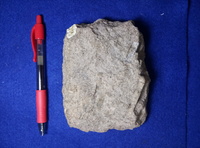 "A trachyte found on the Drachenfels near Bonn, Germany. Grey, fine grained groundmass of rough appearance, containing large crystals of sanidine." - Krantz
"A trachyte found on the Drachenfels near Bonn, Germany. Grey, fine grained groundmass of rough appearance, containing large crystals of sanidine." - Krantz -
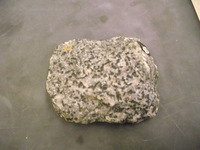 Troctolite
Troctolite -
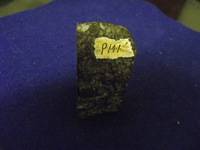 Macroscopic: A Dark Gray Groundmass containing Augite Phenocrysts with some Intercumulus Plagioclase Feldspar Microscopic: The groundmass has a pilotaxitic texture formed from Hornblende and Plagioclase Feldspar Microlites, and some opaque minerals, most likely magnetite. There are also large phenocrysts of Augite. These Phenocrysts have a poikolitic texture with the opaque magnetite poikocrysts. There are also some zoned Pyroxene Phenocrysts.
Macroscopic: A Dark Gray Groundmass containing Augite Phenocrysts with some Intercumulus Plagioclase Feldspar Microscopic: The groundmass has a pilotaxitic texture formed from Hornblende and Plagioclase Feldspar Microlites, and some opaque minerals, most likely magnetite. There are also large phenocrysts of Augite. These Phenocrysts have a poikolitic texture with the opaque magnetite poikocrysts. There are also some zoned Pyroxene Phenocrysts. -
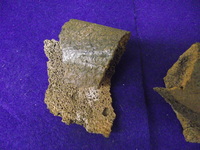 Curled scoria demonstrating the viscosity of basaltic magma. It shows that the viscosity is relatively low, it would flow like a river.
Curled scoria demonstrating the viscosity of basaltic magma. It shows that the viscosity is relatively low, it would flow like a river. -
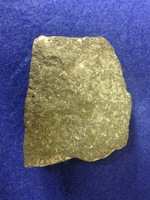 Valmont, Boulder County, Colorado Eocene age MegaL Handsample is a black fine-grained, porphyritic and slightly vesicular rock with phenocrysts of augite and olivine in a fine crystalline groundmass. Micro: Thin Section has pale green augite, olivine and thing subparallel calic plagioclase laths. The matrix is poorly oriented aggregate of small plagioclase laths, grains of augite, olivine, magnetite and accessory biotite and apatite.
Valmont, Boulder County, Colorado Eocene age MegaL Handsample is a black fine-grained, porphyritic and slightly vesicular rock with phenocrysts of augite and olivine in a fine crystalline groundmass. Micro: Thin Section has pale green augite, olivine and thing subparallel calic plagioclase laths. The matrix is poorly oriented aggregate of small plagioclase laths, grains of augite, olivine, magnetite and accessory biotite and apatite. -
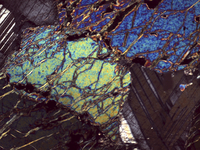 Pyroxenite From Nye, Montana Geologic Age: Precambrian Geologic Name: Stillwater Complex Megascopic Description: A dark greenish gray rock with a most commonly rough granular texture. It is largely composed of orthopyroxene (bronzite) and has a glassy appearance Microscopic Description: The rounded olivines are criss-crossed by thin brownish serpentine veinlets. Anhedral enstatite shows fine grating exsolution structure. Interstitial anhedral calcic plagioclase and clumps of subrounded chromite grains are accessories. Small amounts of clinopyroxene may be present in some section.
Pyroxenite From Nye, Montana Geologic Age: Precambrian Geologic Name: Stillwater Complex Megascopic Description: A dark greenish gray rock with a most commonly rough granular texture. It is largely composed of orthopyroxene (bronzite) and has a glassy appearance Microscopic Description: The rounded olivines are criss-crossed by thin brownish serpentine veinlets. Anhedral enstatite shows fine grating exsolution structure. Interstitial anhedral calcic plagioclase and clumps of subrounded chromite grains are accessories. Small amounts of clinopyroxene may be present in some section. -
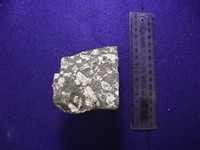 Sample Laf - 107 is a porphyritic rock with the composition of a gabbro. The phenocrysts are plagioclase feldspars in a groundmass of indeterminable (in hand sample) composition. The sample was created through intra-plate oceanic volcanism.
Sample Laf - 107 is a porphyritic rock with the composition of a gabbro. The phenocrysts are plagioclase feldspars in a groundmass of indeterminable (in hand sample) composition. The sample was created through intra-plate oceanic volcanism.
